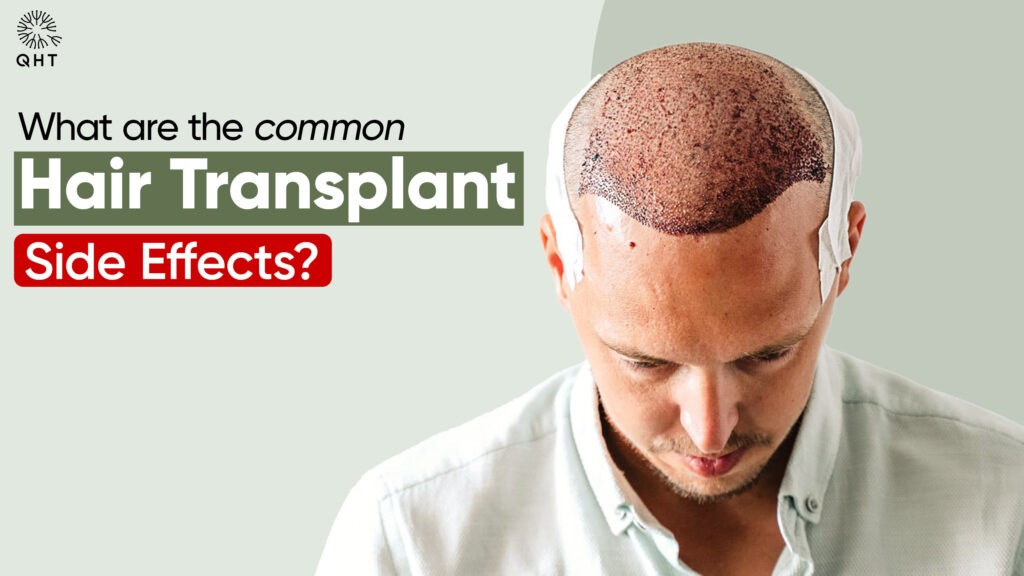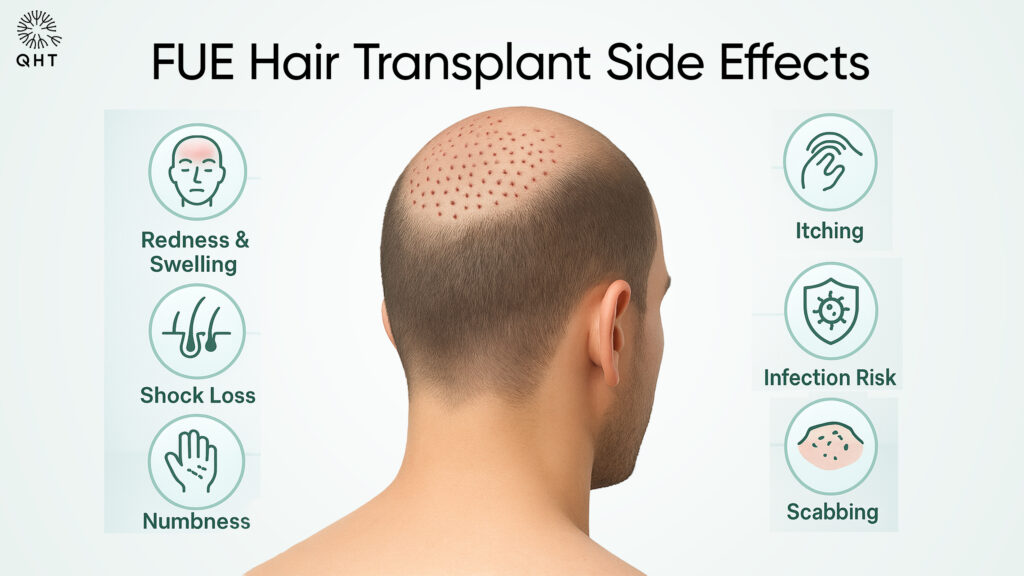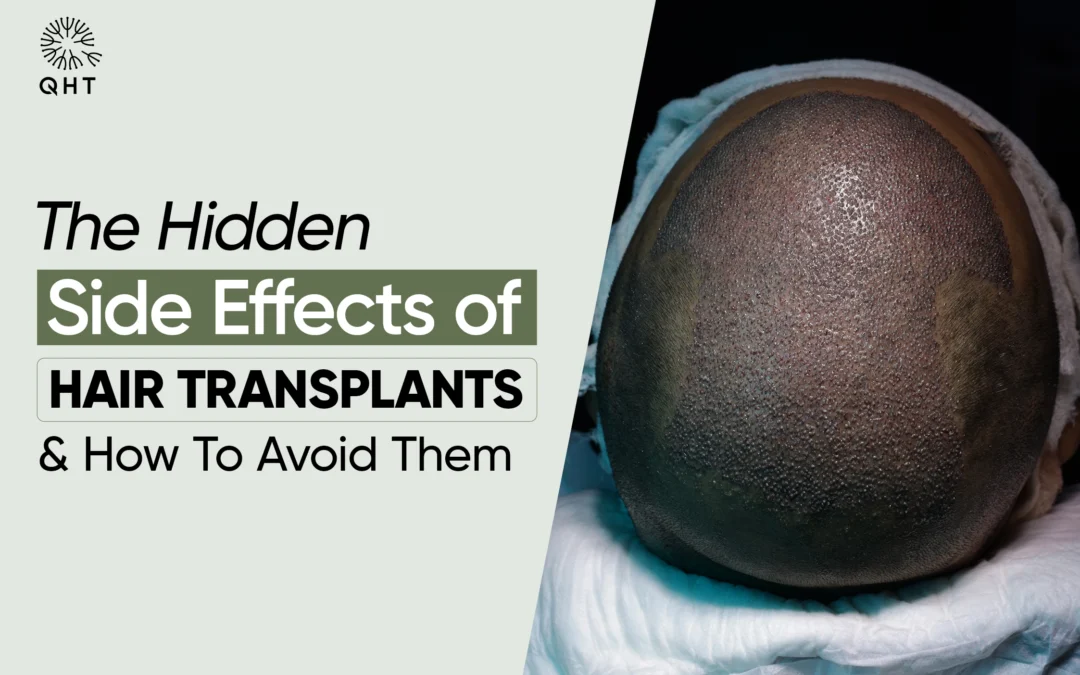Hair transplants have completely changed the lives of countless people, offering not only hair restoration but also a huge boost to confidence, self-esteem, and quality of life. For many of us, experiencing hair loss can be an emotionally difficult process that impacts our appearance, social life, and in some cases, even professional confidence. Fortunately, modern hair restoration techniques now provide an effective, permanent solution to the difficulty of hair loss.
However, hair transplants, like any surgical procedure, may come with risks and potential hair transplant side effects. While side effects from a hair transplant are typically mild and temporary, they may still cause discomfort or anxiety if they were not expected. Understanding the causes, early warning signs, and how to minimize hair restoration side effects is an important part of ensuring an easy and successful transplant.
At QHT Clinic, we prioritize and focus on psychoeducating our patients about the entire hair transplant procedure from scratch. We feel that complete information leads to better outcomes, as well as a more confident and reassuring experience.
This guide outlines the most common hair transplant side effects, explains why they occur, and offers some tips and advice on how to best prevent or deal with them.
What are the common Hair Transplant Side Effects?

1. Swelling of the Scalp and Forehead
Mild swelling is one of the most common hair transplant side effects. Mostly swelling is seen in the forehead and around the eyes, occurring 2-3 days post-operation, usually resolving within 2-4 days at most.
To minimize swelling, you should be sleeping with your head up for the first couple of nights while using cold compresses (but not putting pressure on the transplant site) on the forehead, and following medications as prescribed by the surgeon. This plays a large role in controlling post-operative swelling.
2. Itching
Itching is normal as part of the healing process, as it is a result of scabs being formed and new hair starting to emerge. Itching isn’t dangerous; however, even a mild itch and scratching or rubbing the scalp in the first week can result in dislodging the grafts and altering the final result.
Instead of scratching, using saline sprays or medicated shampoos prescribed by a doctor can help keep the scalp clean.
3. Bleeding
It is very common to see minor bleeding at the donor or recipient site of the procedure within the first few hours after surgery, and it mostly stops on its own. In most occurrences, no intervention is needed to stop the bleeding. To decrease the possibility of excessive bleeding, it is advised to avoid engaging in extraneous physical activity for the first few days.
4. Infection
Infection is rare, but it may occur if the surgical area is exposed to bacteria or dirt. Following the strict post-operative instructions that the surgeon provides, utilize antibiotics as directed, and avoid swimming, saunas, or dusty environments until granted permission to proceed with these activities. If the scalp is clean and well taken care of, it will recover safely.
5. Pain or Discomfort
After a hair transplant, mild discomfort or pain may occur in the donor and/or recipient areas. This is usually manageable with prescribed pain medication. Additionally, limit pressure on your scalp while asleep and avoid wearing tight-fitting hats or fixtures during the early recovery period. Pain management and gentle handling can provide a more relaxing healing time.
6. Shock Loss
“Shock loss” is the term used to describe the temporary loss of hair in both the donor and recipient areas following the hair transplantation procedure. Hair loss at this time is a function of nerve irritation from the surgery itself, and is a normal occurrence of the hair restoration process.
7. Numbness
Temporary numbness resulting from nerve irritation during your hair transplantation procedure is also very common. This is usually transient, lasting only a few weeks. Be patient; typically, sensation returns on its own over time without any special treatment.
Why Side Effects Happen After Hair Transplant Surgery?
Most side effects after a hair transplant occur due to several interconnected factors. Firstly, the incisions made in the donor area for the grafts and the incisions made in the recipient area to place the grafts create a small, but temporary, disruption of the surrounding skin and tissue. This creates temporary swelling, redness, and slight discomfort in the donor area as well as the recipient area.
Secondly, significant inflammatory responses from the body are at play- the scalp responds to the introduction of foreign bodily material when hair follicles are transplanted, which in part causes normal swelling of the scalp and tenderness as they heal.
Finally, temporary, mild trauma occurs to the skin and nerves of the scalp when the incision is made in each area, and can result in post-operative experiences of temporary numbness, tingling, or mild discomfort. These sensations normally resolve over weeks, once the nerves and surrounding tissue recover their normal function.
Understanding the reasons for these reactions is an important consideration for patients. In most cases, through a combination of skilled surgery, a proper and meticulous after-care approach, as well as advanced surgical techniques, side effects following a hair transplant may not be experienced, or at least, minimized to allow for a good recovery. Understanding these factors will also assist patients in developing appropriate expectations for their hair transplant and confidence in their decision.
At QHT Clinic, our experienced staff will ensure that each of our patients receive professional guidance and care to limit potential for side effects and allow for a smooth recovery.
FUE Hair Transplant Side Effects

Follicular Unit Extraction (FUE) is among the most popular procedures across the globe due to its minimal scarring and quick recovery. However, like any procedure, there are unique considerations to remember. A few FUE hair transplant side effects are:
- Small circular scars in the donor region.
- In the surgical area, minor redness or tenderness can be observed for a few days.
- Temporary folliculitis (small pimples in the hair implantation area).
At QHT Clinic, we use advanced extraction tools to minimize tissue trauma, prevent extensive scarring, and improve healing time. We also provide thorough aftercare instructions to ensure patients can effectively manage and prevent these effects altogether.
How To Avoid Hair Transplant Side Effects?
Preventing hair transplant side effects requires a combination of the right medical team, preparation beforehand, post-surgical aftercare, and long-term scalp care. Each one of these four areas is important to limit recovery time and achieve natural long-term results.
Selecting the right clinic & surgeon
Selecting a clinic and surgeon with experience in hair restoration is the first step to minimizing any associated risks. A very skilled surgeon will know and understand the nuances of the hair follicle extraction method and the angles necessary to implant in the recipient site.
At QHT Clinic, we have a team of highly qualified surgeons with clinical experience working with all hair types and difficult cases. They have the skills and competencies necessary to extract and implant grafts full of healthy follicles with precision and attention to detail. We use the latest technology, respect international safety protocols and regulations, all of which limit trauma to the tissues and reduce recovery time.
Preparing the Scalp Before Surgery
Proper pre-surgical preparation can help alleviate post-operative complications.
QHT Clinic will assist you with pre-surgical preparations, including avoiding alcohol, smoking, and medications that thin your blood and increase bleeding and delay healing.
We provide proper guidance on how you can maintain your scalp hygiene and overall health. A healthy, nourished scalp sustains grafts better and minimizes the chances of infection.
Following Post-Operative Instructions
Post-transplant care is critical to reducing complications and extending the lifespan of your transplanted hair; therefore, follow-up is a big consideration at QHT Clinic. The team will provide proper aftercare guidance, including prescribing shampoos and sprays. Scratching or rubbing the areas must be avoided, and the transplanted area must be shielded from the sun for a few days after the transplant.
Patients are also advised to avoid heavy physical activity for a few days from the day of the transplant, as continuous blood flow may shift graft placement. The team at QHT Clinic will follow up closely and is available to answer any questions a patient may have regarding post-operative care. Our primary goal is to help our patients and leave them feeling comfortable through the healing process.
Maintaining Long-Term Scalp Health
Recovery is a time-consuming process that requires constant assistance and support.
At QHT Clinic, we assist patients in sustaining long-term scalp health in order for hair to grow. Patients are advised to stay hydrated, consume a healthy diet, and adhere to any supplement regimens given by their consulting surgeons.
Routine follow-ups at the QHT Clinic allow our surgeons to monitor patients, intervene early in case of any issues arising, and make sure that hair is able to grow as naturally and healthily as possible.
Patients can reduce the chances of side effects after a hair transplant by taking proper measures and adhering to all the recommendations made by their surgeon.
Our Approach At QHT Clinic
At QHT Clinic, patient safety and comfort are our top priorities. We focus on minimizing hair transplant side effects by combining advanced surgical techniques with personalized care.
Our surgeons use minimally invasive procedures like FUE and QHT, reducing tissue trauma, scarring, and recovery time. Patients receive clear pre and post-operative instructions, including guidance on scalp care, medications, and lifestyle adjustments to support healing.
We provide continuous follow-up for both local and international patients, monitoring recovery, addressing concerns promptly, and ensuring optimal results. With our expertise, advanced technology, and dedicated support, QHT Clinic ensures every hair transplant journey is safe, smooth, and worry-free.
Conclusion
The first step towards a safe and successful hair transplant is understanding hair transplant side effects. By selecting an experienced surgeon, preparing accordingly, and diligently following the aftercare instructions, you can avoid hair transplant side effects and enjoy great results that last for years and look natural.
At the QHT Clinic, we have developed the techniques necessary to manage and reduce the risks that hair restoration procedures present while providing you with a great experience.
Take your first step towards restoring your hair, call us to make your consultation appointment today!
Your new hairline and newfound confidence are waiting!

